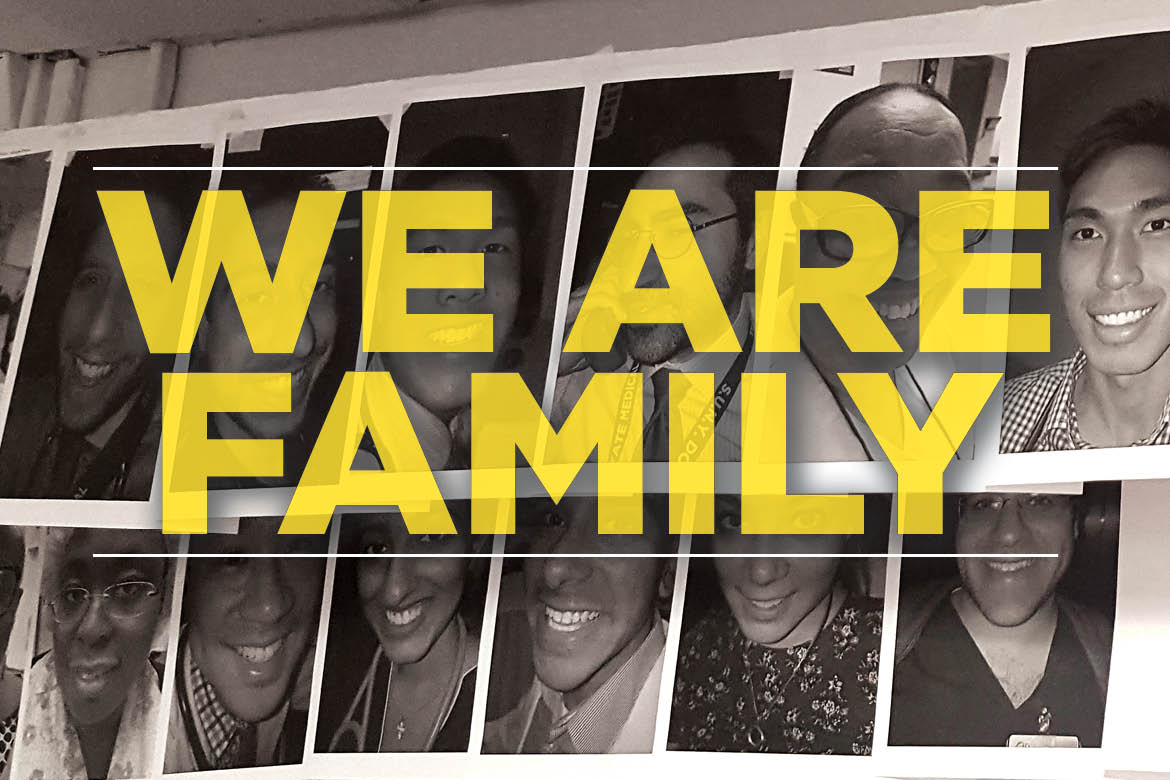These days, when a picture is posted on a wall, both the wall and the picture tend to live in the digital space. A resident at SUNY Downstate Medical Center, however, is discovering that posting real pictures on real walls can build a real-life sense of workplace community in a hospital setting.
The resident-led #WeAreFamily project began as a hobby-horse of Yair Saperstein, MD. At the time, Dr. Saperstein, a first-year resident in internal medicine, was spending a good chunk of his time in the conference room at Kings County Hospital. Initially, he put photos of a few residents on the wall as a joke.
His colleagues found the photos to be endearing and entertaining, and the photo wall quickly gained momentum. Soon it featured images of a majority of the residents on the floor.
Following that, per numerous requests, pictures were added of nurses, attending physicians and staff members. Eventually, photos of a large portion of the employees working on the floor populated the conference room wall.
“We came up with the name, #WeAreFamily,” Dr. Saperstein said. “That really represents us. Everybody that works on the floor was part of the Kings County Hospital family. We all work together and we are just one family.
“It seemed to transform the environment. It made the mood happier. My team was really happy about it, and everybody on the floor embraced this we are family atmosphere.”
The family atmosphere may have also translated to function.
“The first code after we started the project, one of the nurses said, ‘I think it’s the project and we really ran that code well,” Dr. Saperstein said. “It was efficient. The doctors and nurses were communicating effectively. It just worked.”
After the program was successful in its first stint on the sixth floor of Kings County Hospital, Dr. Saperstein brought it with him to three other venues, including his stint working in the ICU at Kings County.
“It was such a change,” he said. “My attending [at the ICU] was the one who commented that I brought in the cheer once I brought in the project. It worked well on each of these two different floors in these two different hospitals, qualitatively.”
First the photos, then the open mic
A 2015 study conducted by researchers at the AMA and the Mayo Clinic found that more than 50 percent of physicians report some degree of burnout. Combating it at the organizational level has proven more effective than on an individual basis.
So, can something as simple as a wall replete with yearbook-style photos do the trick? Based on anecdotal evidence, Dr. Saperstein believes it can.
“Burnout happens for many different reasons,” he said. “It’s something that exists in many programs, including ours. It stems from a lot of different aspects. People feel like they are losing control or not fully autonomous, that they spend a lot of hours at work, but then they don’t get to see all the fruits of the work they do. There’s not quite as much camaraderie as you’d like. This project targets all of those.”
The bond built by the #WeAreFamily project led to additional team-building outings. An open-mic night featuring a variety of staff members, with a variety of talents, was among them.
“The open-mic night was fantastic,” said Vytas Vaitkus, DO, who was one of the chief residents while Dr. Saperstein was implementing the project. “It’s the first time anybody at SUNY Downstate has done anything like that. We had nurses, people from the IT department, medical students, residents and attendings all together, just hanging out. It was a good way to break away from work for a simple evening to socialize with your colleagues outside of a workplace environment.”
Dr. Vaitkus had studied stress and burnout with the SUNY Downstate program and presented his findings during a grand-rounds talk. (Drs. Vaitkus and Saperstein plan to study the impact of the #WeAreFamily project on burnout in the coming months.)
“When I surveyed the residents I asked an open-ended question about how our residents cope with stress or burnout, around 80 percent said that spending time with friends or family is the way to do it,” he said. “Creating these types of events, where we can get together and hang out, is important for people to combat their own stresses.”
- On the road to burnout? How to set a different course
- Better communication with patients linked to less burnout
- Burnout’s causes, fixes need rigorous research, says expert panel




